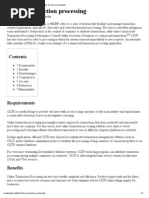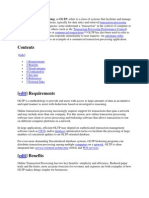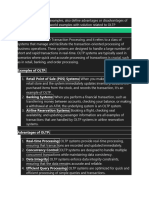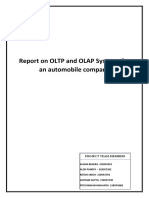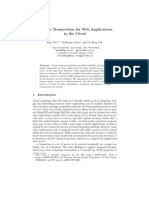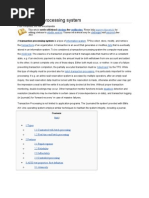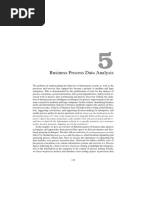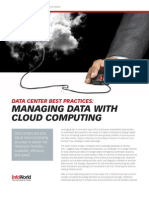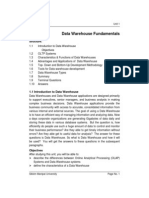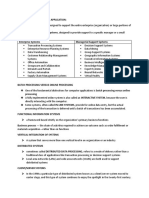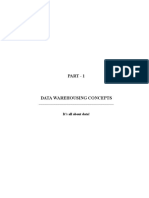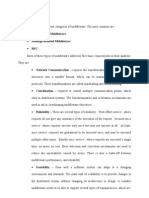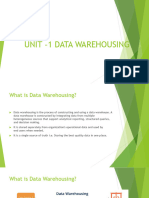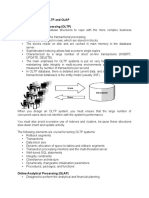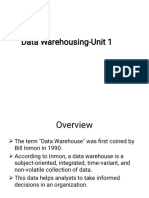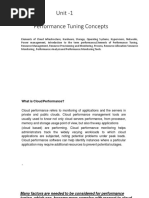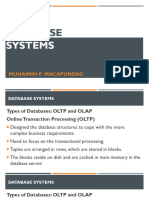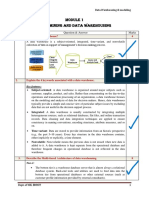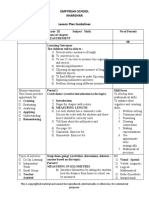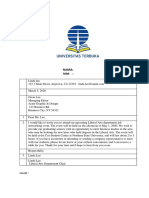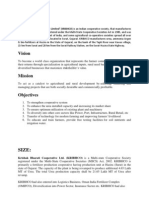Online Transaction Processing
Online Transaction Processing
Uploaded by
Harleen KaurCopyright:
Available Formats
Online Transaction Processing
Online Transaction Processing
Uploaded by
Harleen KaurOriginal Title
Copyright
Available Formats
Share this document
Did you find this document useful?
Is this content inappropriate?
Copyright:
Available Formats
Online Transaction Processing
Online Transaction Processing
Uploaded by
Harleen KaurCopyright:
Available Formats
Online transaction processing
From Wikipedia, the free encyclopedia
This article relies largely or entirely upon a single source. Relevant discussion may
be found on the talk page. Please help improve this article by introducingcitations to
additional sources. (March 2013)
Online transaction processing, or OLTP, is a class of information systems that facilitate and
manage transaction-oriented applications, typically for data entry and retrieval transaction
processing. The term is somewhat ambiguous; some understand a "transaction" in the context of
computer or database transactions, while others (such as the Transaction Processing Performance
Council) define it in terms of business or commercial transactions.[1] OLTP has also been used to
refer to processing in which the system responds immediately to user requests. An automated teller
machine (ATM) for a bank is an example of a commercial transaction processing application. Online
transaction processing applications are high throughput and insert or update-intensive in database
management. These applications are used concurrently by hundreds of users. The key goals of
OLTP applications are availability, speed, concurrency and recoverability. [2] Reduced paper trails and
the faster, more accurate forecast for revenues and expenses are both examples of how OLTP
makes things simpler for businesses. However, like many modern online information technology
solutions, some systems require offline maintenance, which further affects the cost-benefit analysis
of online transaction processing system.
Contents
[hide]
1 What Is an OLTP System?
2 Online Transaction Processing Systems Design
3 Contrasted to
4 See also
5 References
6 External links
What Is an OLTP System?[edit]
OLTP system is a popular data processing system in today's enterprises. Some examples of OLTP
systems include order entry, retail sales, and financial transaction systems. [3] Online transaction
processing system increasingly requires support for transactions that span a network and may
include more than one company. For this reason, modern online transaction processing software
use client or server processing and brokering software that allows transactions to run on different
computer platforms in a network.
In large applications, efficient OLTP may depend on sophisticated transaction management software
(such as CICS) and/ordatabase optimization tactics to facilitate the processing of large numbers of
concurrent updates to an OLTP-oriented database.
For even more demanding decentralized database systems, OLTP brokering programs can
distribute transaction processing among multiple computers on a network. OLTP is often integrated
into service-oriented architecture (SOA) and Web services.
Online Transaction Processing (OLTP) involves gathering input information, processing the
information and updating existing information to reflect the gathered and processed information. As
of today, most organizations use a database management system to support OLTP. OLTP is carried
in a client server system.
Online Transaction Process concerns about concurrency and atomicity. Concurrency controls
guarantee that two users accessing the same data in the database system will not be able to change
that data or the user has to wait until the other user has finished processing, before changing that
piece of data. Atomicity controls guarantee that all the steps in transaction are completed
successfully as a group. That is, if any steps between the transaction fail, all other steps must fail
also.[4]
Online Transaction Processing Systems Design[edit]
To build an OLTP system, designer must know that the large number of concurrent users does not
interfere with the system's performance. To increase the performance of OLTP system, designer
must avoid the excessive use of indexes and clusters.
The following elements are crucial for the performance of OLTP systems:[5]
Rollback segments
Rollback segments are the portions of database that record the actions of transactions in the
event that a transaction is rolled back. Rollback segments provide read consistency, roll back
transactions, and recover the database.[6]
Clusters
A cluster is a schema that contains one or more tables that have one or more columns in
common. Clustering tables in database improves the performance of join operation.[7]
Discrete transactions
All changes to the data are deferred until the transaction commits during a discrete
transaction. It can improve the performance of short, non-distributed transaction. [8]
Block (data storage) size
The data block size should be a multiple of the operating system's block size within the
maximum limit to avoid unnecessary I/O.[9]
Buffer cache size
To avoid unnecessary resource consumption, tune SQL statements to use the database
buffer cache.[10]
Dynamic allocation of space to tables and rollback segments
Transaction processing monitors and the multi-threaded server
A transaction processing monitor is used for coordination of services. It is like an operating
system and does the coordination at a high level of granularity and can span multiple
computing devices.[11]
Partition (database)
Partition increases performance for sites that have regular transactions while still maintain
availability and security.[12]
database tuning
With database tuning, OLTP system can maximize its performance as efficiently and rapidly
as possible.
You might also like
- Ielts Writing Task 1 - No Change - 2 Items HandoutDocument3 pagesIelts Writing Task 1 - No Change - 2 Items HandoutBùi Hằng100% (2)
- The Diabetic Exchange List PDFDocument14 pagesThe Diabetic Exchange List PDFinkpen56789No ratings yet
- Online Transaction Processing - Wikipedia, The Free EncyclopediaDocument3 pagesOnline Transaction Processing - Wikipedia, The Free Encyclopediaarjun.lnmiitNo ratings yet
- Online Transaction Processing, or OLTP, Refers To A Class ofDocument21 pagesOnline Transaction Processing, or OLTP, Refers To A Class ofArchway MediaNo ratings yet
- Online Transaction ProcessingDocument17 pagesOnline Transaction ProcessingJavzaaNo ratings yet
- Transaction Processing System SimDocument11 pagesTransaction Processing System SimPutu Adi SusantaNo ratings yet
- Transaction Processing System - WikipediaDocument7 pagesTransaction Processing System - WikipediaEkaterina JazminNo ratings yet
- 18bit51c U4 PDFDocument39 pages18bit51c U4 PDFDinesh BNo ratings yet
- MIS Assignment: by Rubina Naaz Mba 4 SemDocument9 pagesMIS Assignment: by Rubina Naaz Mba 4 SemXoheb KhanNo ratings yet
- Distributed Systems: CDLM Ingegneria Informatica (Politecnico Di Bari)Document17 pagesDistributed Systems: CDLM Ingegneria Informatica (Politecnico Di Bari)Passw GrabberNo ratings yet
- Bi Lectures ChatgptDocument48 pagesBi Lectures Chatgptjr.developer.78No ratings yet
- Report On OLTP and OLAP Systems For An Automobile Company: Project Team MembersDocument6 pagesReport On OLTP and OLAP Systems For An Automobile Company: Project Team MembersALISHA BEHERANo ratings yet
- Transaction Processing SystemDocument11 pagesTransaction Processing SystemAkhil GRNo ratings yet
- Data WarehouseDocument12 pagesData Warehousemattew657100% (1)
- Term 1Document12 pagesTerm 1abhijeetrajput90281No ratings yet
- Scalable Transactions For Web Applications in The CloudDocument12 pagesScalable Transactions For Web Applications in The CloudEsther Grace VinithaNo ratings yet
- Data Warehouse: From Wikipedia, The Free EncyclopediaDocument5 pagesData Warehouse: From Wikipedia, The Free EncyclopediaRajan SharmaNo ratings yet
- Transaction Processing SystemDocument26 pagesTransaction Processing SystemAwadheshwari PatelNo ratings yet
- Data WarehouseDocument56 pagesData WarehouseNoor ThamerNo ratings yet
- Project Report ErpDocument29 pagesProject Report ErpasgyNo ratings yet
- Cloud Computing Guide 1561727Document4 pagesCloud Computing Guide 1561727karanmahajanNo ratings yet
- Data Warehouse and Mining-1Document40 pagesData Warehouse and Mining-1abhijeetrajput90281No ratings yet
- In Computer ScienceDocument13 pagesIn Computer Sciencechukwudi01No ratings yet
- CloudTPS Scalable Transactions For Web Applications in The CloudDocument16 pagesCloudTPS Scalable Transactions For Web Applications in The Clouddeepukr85No ratings yet
- Unit 1 Data Warehouse Fundamentals: StructureDocument10 pagesUnit 1 Data Warehouse Fundamentals: StructureAienla AierNo ratings yet
- Lecturenotes BCS403 DatabasemanagementsystemDocument18 pagesLecturenotes BCS403 Databasemanagementsystemtharanir.aimlNo ratings yet
- Module 5Document35 pagesModule 5surajnaidu73No ratings yet
- Pre 3 Midterm Reviewer NerfedDocument4 pagesPre 3 Midterm Reviewer NerfedMary Ann GurreaNo ratings yet
- Informatica and Datawarehouse PDFDocument156 pagesInformatica and Datawarehouse PDFsmruti_2012No ratings yet
- DWH & Data ModelingDocument50 pagesDWH & Data ModelinggeoinsysNo ratings yet
- OLTP (On-Line Transaction Processing) Is Characterized by A Large Number of Short On-Line TransactionsDocument12 pagesOLTP (On-Line Transaction Processing) Is Characterized by A Large Number of Short On-Line TransactionseazyNo ratings yet
- Types of Middle WareDocument20 pagesTypes of Middle WareNeemaNo ratings yet
- OLTP (On-Line Transaction Processing) Is Characterized by A Large Number of Short On-Line TransactionsDocument10 pagesOLTP (On-Line Transaction Processing) Is Characterized by A Large Number of Short On-Line TransactionseazyNo ratings yet
- TheoeyDocument114 pagesTheoeysonabeta07No ratings yet
- Assignment 2part 3 Asynchronou MiddlewareDocument18 pagesAssignment 2part 3 Asynchronou MiddlewareعليNo ratings yet
- Explain About Web Service?: SOA Interview QuestionsDocument80 pagesExplain About Web Service?: SOA Interview QuestionsVibhav SinghNo ratings yet
- Purpose: Database TransactionDocument3 pagesPurpose: Database TransactionRamlal ChavanNo ratings yet
- DWM Unit 1Document48 pagesDWM Unit 1Hetvy JadejaNo ratings yet
- Introduction On Data Warehouse With OLTP and OLAP: Arpit ParekhDocument5 pagesIntroduction On Data Warehouse With OLTP and OLAP: Arpit ParekhEka PonkratovaNo ratings yet
- Chapter 5Document5 pagesChapter 5Niel Franco BalosNo ratings yet
- Enterprise Application Characteristics: 3.1 Diverse ApplicationsDocument4 pagesEnterprise Application Characteristics: 3.1 Diverse ApplicationsAlexandru MoldovanNo ratings yet
- What Is Client-Server Computing? Client/server Is A Computational Architecture That Involves Client Processes Requesting Service From Server ProcessesDocument4 pagesWhat Is Client-Server Computing? Client/server Is A Computational Architecture That Involves Client Processes Requesting Service From Server Processesmasoom_bansal22No ratings yet
- Times Tend BDocument3 pagesTimes Tend BMadasamy GanapathyNo ratings yet
- Olap Vs OltpDocument9 pagesOlap Vs OltpnavneetccnaNo ratings yet
- DW Unit-1 (1) XXXXXXXXDocument70 pagesDW Unit-1 (1) XXXXXXXXDhananjay JahagirdarNo ratings yet
- Unit 1 Data Warehouse Fundamentals: StructureDocument10 pagesUnit 1 Data Warehouse Fundamentals: StructureAmit ParabNo ratings yet
- Bit 3107 3Document7 pagesBit 3107 3p-jornNo ratings yet
- Oracle BI - Topic - Data WarehousingDocument4 pagesOracle BI - Topic - Data WarehousingAbebeNo ratings yet
- Data Warehouse ReferencesDocument40 pagesData Warehouse ReferencesTristan Luis Ramiro TabernillaNo ratings yet
- CPT FullDocument153 pagesCPT FullNirma VirusNo ratings yet
- Pharma Batch: Data WarehousingDocument32 pagesPharma Batch: Data WarehousingrmeralaNo ratings yet
- Inroduction To Client Server Computer - TCA8C23Document16 pagesInroduction To Client Server Computer - TCA8C23mohamedabdulla1988100% (1)
- CH3 Database SystemsDocument20 pagesCH3 Database Systemshxxx.games105No ratings yet
- BDAM - Assignment 1 - Group 2Document8 pagesBDAM - Assignment 1 - Group 2Pankhuri BhatnagarNo ratings yet
- Module1-Question Bank With Answers (1) - 2Document23 pagesModule1-Question Bank With Answers (1) - 2Vaishnavi G . RaoNo ratings yet
- Module 1 Olap - OltpDocument12 pagesModule 1 Olap - OltpAdrine KingNo ratings yet
- Description: Oracle 10g TablespacesDocument5 pagesDescription: Oracle 10g TablespacesSUBIN BABYNo ratings yet
- Application Server and EAIDocument6 pagesApplication Server and EAIRajesh M ReddyNo ratings yet
- Computer Science Self Management: Fundamentals and ApplicationsFrom EverandComputer Science Self Management: Fundamentals and ApplicationsNo ratings yet
- The Monkey and The Crocodile Story PDFDocument4 pagesThe Monkey and The Crocodile Story PDFHarleen KaurNo ratings yet
- The Lion and The MouseDocument3 pagesThe Lion and The MouseHarleen Kaur100% (1)
- OpTransactionHistory12 10 2017 PDFDocument1 pageOpTransactionHistory12 10 2017 PDFHarleen KaurNo ratings yet
- OpTransactionHistory12 10 2017 PDFDocument1 pageOpTransactionHistory12 10 2017 PDFHarleen KaurNo ratings yet
- Transport or Transportation Is The Movement of People, Animals andDocument14 pagesTransport or Transportation Is The Movement of People, Animals andHarleen KaurNo ratings yet
- E-Commerce: Electronic Commerce, Commonly Known As E-Commerce or Ecommerce, Is A Type of Industry Where TheDocument16 pagesE-Commerce: Electronic Commerce, Commonly Known As E-Commerce or Ecommerce, Is A Type of Industry Where TheHarleen KaurNo ratings yet
- Empyrean School Kharghar Lesson Plan Guidelines: PurposesDocument3 pagesEmpyrean School Kharghar Lesson Plan Guidelines: PurposesHarleen KaurNo ratings yet
- Electronic Business: HistoryDocument1 pageElectronic Business: HistoryHarleen KaurNo ratings yet
- Impact of Leadership Styles On EmployeesDocument11 pagesImpact of Leadership Styles On Employeesabubakari ibrahimNo ratings yet
- Y-P3-AM-WAM - UserManual - EN - PagerDocument29 pagesY-P3-AM-WAM - UserManual - EN - Pageralbu mihailNo ratings yet
- 3gallergy 2020 - Specific - IgE - Universal - Kit - IMMULITE - 2000 - Systems - Rev - 32 - DXDCM - 09017fe9804a6eb0-1598648757334Document49 pages3gallergy 2020 - Specific - IgE - Universal - Kit - IMMULITE - 2000 - Systems - Rev - 32 - DXDCM - 09017fe9804a6eb0-1598648757334Pierre LavoisierNo ratings yet
- 854 MEAT AID2TTI234 Nishiawa Japanese Wagyu A5Kg: No. Kategori Barang Kode Barang Nama Barang SatuanDocument30 pages854 MEAT AID2TTI234 Nishiawa Japanese Wagyu A5Kg: No. Kategori Barang Kode Barang Nama Barang Satuanmhijrah147No ratings yet
- Genset+Charge Discharge Bussiness Case OperationDocument7 pagesGenset+Charge Discharge Bussiness Case OperationadisofaNo ratings yet
- Unit 4 - Instrumentation and ControlDocument15 pagesUnit 4 - Instrumentation and ControlKalakriti IITINo ratings yet
- False FriendsDocument2 pagesFalse FriendsTemur Legendary100% (1)
- How To Create A NewsletterDocument5 pagesHow To Create A Newsletterkhalid100% (1)
- Db898h60e SXDocument1 pageDb898h60e SXana camila escobarNo ratings yet
- Tugas B InggrisDocument6 pagesTugas B Inggrisiqbal baleNo ratings yet
- Wabeco Maschinenprospekt ENDocument60 pagesWabeco Maschinenprospekt ENHernández Palafox Bryan MichelNo ratings yet
- Paper Car Collision Engineering ProjectDocument4 pagesPaper Car Collision Engineering Projectapi-489549608No ratings yet
- Zno StrategiesDocument16 pagesZno StrategiesКирилл ЛахноNo ratings yet
- Week 14 CD QUIZ 21Document2 pagesWeek 14 CD QUIZ 21tina santiagoNo ratings yet
- Kitab - Ulama'Ul MujaddidunDocument58 pagesKitab - Ulama'Ul Mujaddidunkangza371No ratings yet
- Enable DIF For EquipmentDocument20 pagesEnable DIF For EquipmentMahesh PidshettiNo ratings yet
- Catlogue Bearing Special For RobotDocument12 pagesCatlogue Bearing Special For RobotIonutNo ratings yet
- Queensland Residency DeclarationDocument1 pageQueensland Residency DeclarationphuNo ratings yet
- Pod Terminating Stuck OpenshiftDocument4 pagesPod Terminating Stuck OpenshiftRajesh Mn RajNo ratings yet
- REFERENCES Mohammad Emadul Huda SirDocument5 pagesREFERENCES Mohammad Emadul Huda SirMd. Saddam HossainNo ratings yet
- Types of LibraryDocument17 pagesTypes of LibrarynoorbinaanshadNo ratings yet
- Forest Hills Logistics Corporation - PafDocument1 pageForest Hills Logistics Corporation - PafSaiNo ratings yet
- CH 10 - MicroDocument41 pagesCH 10 - MicroRitika NandaNo ratings yet
- 50 Scatter Sheets (Sample)Document16 pages50 Scatter Sheets (Sample)dumbo230% (1)
- Part 2. Evaluation Process - MechanicalDocument42 pagesPart 2. Evaluation Process - MechanicalEmilNo ratings yet
- Final Khibhco AssignmentDocument3 pagesFinal Khibhco AssignmentmaheshbarvaliyaNo ratings yet
- Advance RulingDocument4 pagesAdvance RulingmarlynNo ratings yet
- Free Drug Bank GUIDE 3 PDFDocument128 pagesFree Drug Bank GUIDE 3 PDFRaouf Ra'fat Soliman88% (8)



